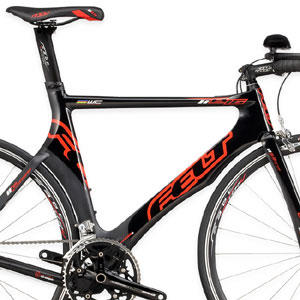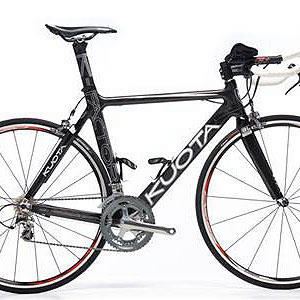
Fuji Aloha 1.0
This bike has two problems: it's an aluminum bike swimming in a sea of carbon sharks; and it's the more expensive of two bikes sharing a similar frame motif.
Bike models are like real estate: if you want the best bargain, you buy the worst house in the best neighborhood. In the world of bikes, if you want the best value, you buy the best frame with the cheapest parts. That happens, in this case, to be the Aloha 2.0, which sell for $1600 compared to the 1.0's $2400.
Now, this isn't exactly fair, because these two Fuji models do not share the same frame. This 1.0 is an A-6 alloy aero frame—a lighter, extruded tubing—with a carbon aero 2-position post, whereas the less expensive Aloha 2.0 frame is an Altair 2—a more entry level frame—with a single position carbon aero seatpost. The seatposts are not interchangeable, so, you can theoretically get into a configuration on the 1.0 not available to you on the 2.0. The tube shapes on the frame are different—notably the top tube and seat stays—and the welding is different. And, the 1.0 has internal cable routing while the 2.0 has its cables routed externally.
The questions for Fuji are two: 1) Does its retailer base—in the aggregate—understand the difference between the two Aloha frames? 2) Can Fuji sell the Aloha 1.0 against Cervelo's complete P2, and against bikes like the QR Seduza, Felt's B16, and other all-carbon framed complete bikes that sell anywhere from $150 to $400 less?
I'm a big fan of the Aloha 2.0, and I think the Fuji Aloha 1.0 can be sold and ridden successfully. But the cheaper Fuji is, I think, an easy sell, while retailers might have to push a bit to get this particular model out the door.

Giant Trinity Alliance 1
This is a good value in a good neighborhood, that is to say, it's half the price of the Trinity Alliance 0, though it's the same frame. It's a great frame, made by a great company—in perhaps the World's premier carbon bike factory—in very good geometry, at an attractive price.
Its problem? It's made partly out of aluminum, and aluminum is radioactive. Who knew that when the bike industry holds a Geiger counter up to this metal, it goes off?
The funny thing about it: this frame is largely carbon. Just the fact, though, that it's got some aluminum in the frame is enough to tarnish its salability, even though aluminum is used where that material's stiffness is employed to great utility, while carbon is used to tune the ride through its lay-up in the mold.
Giant has done a singularly superb job of making a frame, and is a singular failure as a marketer and seller of that frame. Giant has gone from a popularity of 1 percent among Slowtwitchers, in 2007, to 2 percent in 2009 (in polls taken on of Slowtwitch readers). How can such a good bike, from such a good company, perform this poorly in a category this important to the American retail market? It's a mystery.
The bike is spec'd quite nicely, with Sapim spokes in its wheels, Michelin Pro Race 3 tires, a Fizik Arione Tri 2 saddle, and Visiontech aerobars which turn out to be a great geometric match for the frame. The bike comes in 4 sizes and, except for the unfortunate lack of a 650c wheeled bike for the smallest riders, are well graded.


